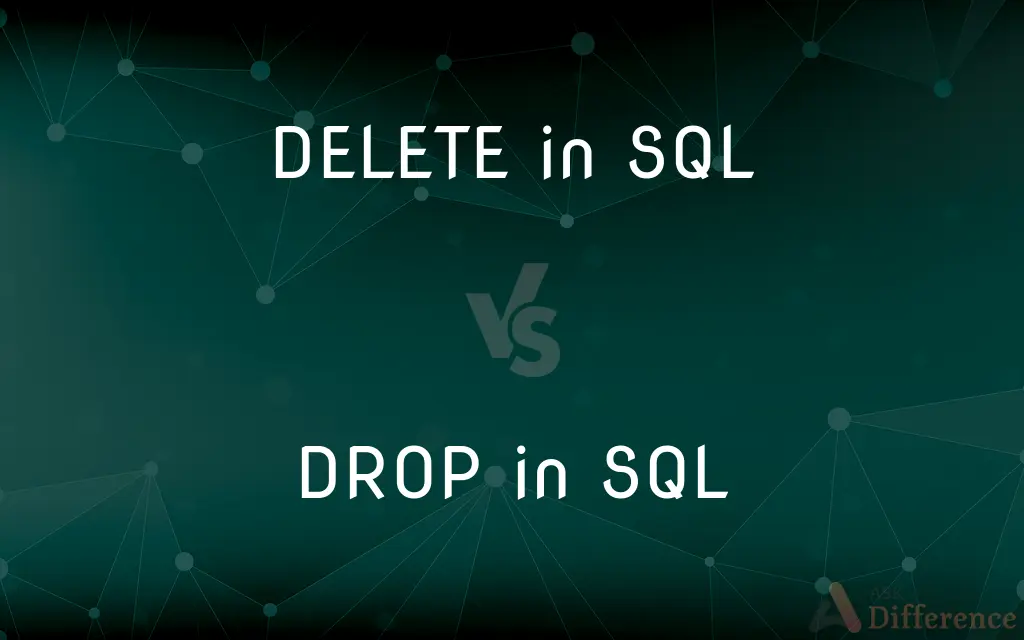DELETE in SQL vs. DROP in SQL — What's the Difference?
By Tayyaba Rehman — Published on January 17, 2024
DELETE in SQL removes rows from a table while keeping its structure intact. DROP in SQL deletes an entire table, erasing its structure and data permanently.

Difference Between DELETE in SQL and DROP in SQL
Table of Contents
ADVERTISEMENT
Key Differences
DELETE in SQL removes specific rows from a table based on defined conditions while retaining the table's structure. It alters the table's data content without affecting its design, allowing precise data removal without compromising the table's existence.
Contrarily, DROP in SQL eliminates entire tables, including their structure and stored data. It completely erases the table from the database, making it irrecoverable. This command isn't specific to rows but deletes the entire table itself.
It's a data manipulation command used to remove specific rows from a table, maintaining the table's existence and structure. It helps in managing database content by eliminating unnecessary data entries.
Conversely, DROP in SQL is a data definition language command that irreversibly removes an entire table, including its structure and stored data. It's critical to exercise caution as it's irreversible and permanently eliminates the table.
Primarily, DELETE in SQL is utilized for targeted removal of specific records within a table, providing a means to clean up or modify stored data.
ADVERTISEMENT
In contrast, DROP in SQL serves to completely remove tables from the database, necessitating careful consideration due to its irreversible nature.
Comparison Chart
Function
Removes specific rows from a table
Erases entire tables, including structure and data
Impact
Alters table data without changing structure
Permanently eliminates table, irrecoverable
Scope
Deletes rows based on conditions
Removes entire tables from the database
Recoverability
Removed rows can be restored if needed
Irreversible, no recovery once table is dropped
Usage
Eliminates unnecessary data entries
Removes entire tables, careful consideration necessary
Compare with Definitions
DELETE in SQL
Alters table content by eliminating targeted rows.
DELETE in SQL helps clean up unnecessary data entries.
DROP in SQL
Removes tables entirely, making them irrecoverable.
The DROP in SQL command deletes tables permanently.
DELETE in SQL
Allows selective data removal without affecting the table's existence.
With DELETE in SQL, unwanted data entries can be easily eliminated.
DROP in SQL
Critical command, requires careful consideration before execution.
Avoid accidental table deletions by double-checking DROP in SQL queries.
DELETE in SQL
Deletes specific records, preserving the table's structure.
The DELETE in SQL command removed outdated customer records.
DROP in SQL
Irreversibly eliminates entire tables from the database.
Using DROP in SQL, I erased the outdated table from the database.
DELETE in SQL
Used to manage and modify stored data content efficiently.
DELETE in SQL ensures the table contains relevant, up-to-date information.
DROP in SQL
Erases tables along with their structure and stored data.
Be cautious, as DROP in SQL permanently deletes entire tables.
DELETE in SQL
Removes specific rows from a table based on defined criteria.
Using DELETE in SQL, I removed all completed orders from the table.
DROP in SQL
Irreversible command for deleting tables from the database.
After executing DROP in SQL, the table is permanently removed.
Common Curiosities
Can it restore deleted rows from a table?
Yes, if a backup or history exists, deleted rows can sometimes be recovered.
Is data recovery possible after using this command?
No, DROP in SQL permanently erases entire tables, making recovery impossible.
Does it affect only specific records within a table?
No, DROP in SQL removes the entire table, including all its records.
What's its primary function?
It selectively removes specific rows from a table.
Does it change the table's structure?
No, it only alters the data within the table.
Does it require careful consideration before execution?
Yes, especially when targeting specific rows, to avoid unintended data loss.
Can it be used to erase only specific data entries?
No, it removes entire tables and their stored data.
Is it suitable for table cleanup?
Yes, DELETE in SQL helps manage and clean up table data effectively.
Does it impact table integrity?
When used correctly, it maintains table integrity while removing data.
Is it reversible after execution?
It might be reversible based on backups or transaction logs.
Is there any way to recover data once a table is dropped?
No, data from a dropped table is permanently lost.
Can it accidentally delete tables?
Yes, it's essential to double-check DROP commands to prevent accidental deletions.
Can it be undone once executed?
No, DROP commands cannot be undone or reversed.
Can it be used to remove specific rows?
No, DROP in SQL is exclusively for removing entire tables.
Is it reversible if the database crashes?
In some cases, recent changes might be recoverable from backups or logs.
Share Your Discovery

Previous Comparison
Steve Madden vs. ALDO
Next Comparison
Florsheim vs. Cole HaanAuthor Spotlight
Written by
Tayyaba RehmanTayyaba Rehman is a distinguished writer, currently serving as a primary contributor to askdifference.com. As a researcher in semantics and etymology, Tayyaba's passion for the complexity of languages and their distinctions has found a perfect home on the platform. Tayyaba delves into the intricacies of language, distinguishing between commonly confused words and phrases, thereby providing clarity for readers worldwide.











































